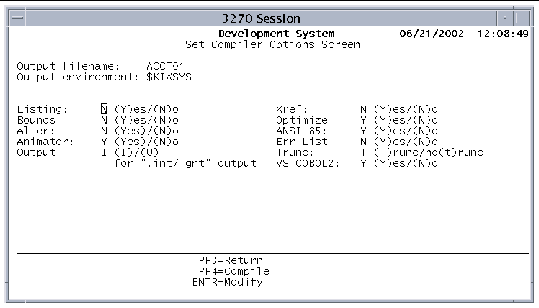Pl I To Cobol Converterlite
Hi all,iテつエm looking for a chance to write one and the same Outputfile from a Cobol-Mainprogram and a PLI-Subprogramm (with Fetch or static Link).Main(Cobol): Write Hallo 1Call PLI-SUBPLI-SUB: Write Hallo 2returnMain(Cobol): Write Hallo 3End.This is, what i want:Hallo 1Hallo 2Hallo 3Any Idea?Thanks for Help!Regards,MartinP.S. Without an Open in PLI, PLI opens the File implicit, the Output before in Cobol is going to Discharge. (( Posts: 4 Joined: Mon Nov 03, 2008 2:36 pm Has thanked: 0 time Been thanked: 0 time. Hello Dick,sorry, I mean the output from the pli-program is lost.First I open the Outputfile in the Cobol-Mainprogramm. Then I write one line into the file.After that, I call the PLI-Subprogram. There is the same OutputFile-Declaration in this program (just in PLI). Now i write the second line in that file without an Open in the Subprogram.
After that, i return to Main-Program (Cobol) and write the third line. After all, I close the File in Mainprogramm.The content in the File ist the second and third row, the first row is lost.What can I do to all three lines secure?- Two in Cobol - One in PLI - all in the same file.?Do you have an idea?Regards,Martin Posts: 4 Joined: Mon Nov 03, 2008 2:36 pm Has thanked: 0 time Been thanked: 0 time.
Disclosure: Your support helps keep the site running! We earn a referral fee for some of the services we recommend on this page.PL/I is a legacy programming language invented by IBM in the early 1960s. The intention was to create a language which would have the scientific computing capabilities of, and the business data-processing power of. A Quick Note on the NameMany people prefer to call this programming language PL/1. They argue that early typewriters did not have a “1” character and that the capital “I” character was used instead. It is certainly true that whether PL/I or PL/1, the full name of it is Programming Language One. We have used PL/I because it is the more commonly used.
Whichever version is used, it should not confuse anyone. A Brief History of PL/IPL/I began life as part of an attempt to unify business and scientific computing. In the early 1960s, business computing was being done mostly in COBOL, while developers in science, math, and academia were mostly using Fortran. Even the hardware used by the two communities was different.
IBM wanted move everyone onto a common hardware platform (the ), and wanted a common programming language to go along with it.The team tasked with creating this common language initially attempted to begin with Fortran and extend it to add the required features from COBOL. This proved unsuccessful, and they began work on a new language altogether, based loosely on. The new language was briefly named NPL (“new programming language”), and then MPPL (“Multi-purpose programming language”), and then finally PL/I.The first description of the language (still called NPL) was released in 1964. The first compiler came out in 1966. In 1967 work began writing a complete specification of the language.
Online ResourcesPL/I was a relatively uncommon language even in its heyday. So tracking down good resources for learning and using the language is a little tough. Lucky for you, we’ve done the hard work and have gathered up the best PL/I resources available. Tutorials., a very thorough introduction to the language;.

Pl1 Programming Guide
(PDF), detailed slides for a PL/I presentation.Video Tutorials., a 19-part video tutorial series;., a quick video introduction to the language.Reference.;. (PDF), complete guide to using PL/I on various IBM architectures ( );.Historical MaterialsIf you are working on a legacy PL/I system, it is probable that you won’t be working with the latest version of the language.